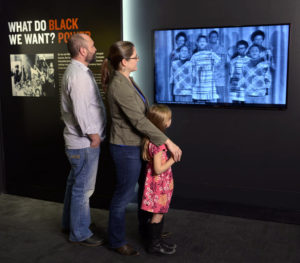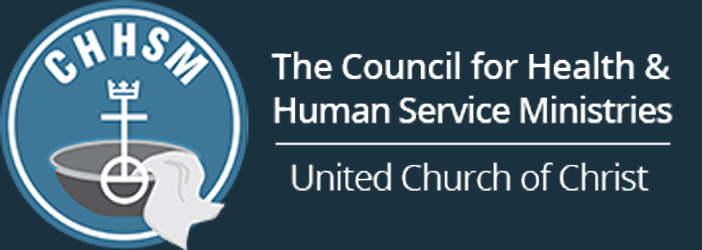Visit to National Civil Rights Museum to Ground, Inspire CHHSM Annual Gathering

The original lunch counter sit-in exhibit includes historical perspectives as well as information on the nonviolent protest training that participants were required to complete.
The UCC’s Council for Health and Human Service Ministries opens its Annual Gathering March 3 in Memphis. But CHHSM’s annual event will kick off the day before with a special gathering to set the tone of the entire meeting.
On March 2, CHHSM attendees will visit the National Civil Rights Museum, a Smithsonian affiliate in Memphis. The visit “will allow people to reflect on centuries of U.S. history and the struggle within our society to confront discrimination and demand justice,” says the Rev. George Graham, CHHSM vice president. “I hope that people will be inspired to stand up for equality today, whatever their setting, to connect their vocation with ministries of justice and grace, so that together we can work to create a just, caring, and compassionate world.”
The museum campus, which takes 2-3 hours to tour, is comprised of two buildings: the Lorraine Motel where the Rev. Martin Luther King Jr. was assassinated in 1968; and the Legacy Building, the former boarding house across the street, where history suggests that James Earl Ray fired the shot that killed the civil rights leader.

In the Legacy Building, visitors experience the search for James Earl Ray following the assassination of King.
“The museum will provide perspective on the need for justice and grace in our country, and of how much there is to learn and as a result of the way African Americans have been treated throughout U.S. history,” says Michael J. Readinger, CHHSM president and CEO. “I hope the experience instills a sense of resolve that we, as a country, never repeat these behaviors again.”
The evening of March 2 will be devoted to museum reflection time led by two staff members of UCAN, a CHHSM member that works with disadvantaged youth in Chicago.
“Mary Whiting, program manager, and Michael Ann Wiley, licensing supervisor, were chosen to lead the reflection group based on their proposed workshop of a similar nature on unpacking vicarious trauma,” says Paula Barker, CHHSM’s executive assistant for events and administration. “It’s important for our members to come early to support the mission and vision of CHHSM — to create a just, caring and compassionate world. This is our work.”

Among the poignant displays at the museum is one of the damaged buses from the 1961 Freedom Rides.
Museum exhibits at the Lorraine Motel include “Slavery in America, 1619-1861,” which offers a graphic representation of the global impact of slavery. Set up in a circular gallery, visitors walk on a floor map of the Americas, Europe and Asia. Illuminated channels provide statistics and information about the Atlantic slave trade, including the massive number of people captured, goods cultivated and wealth created.
Another exhibit at the motel, “Standing Up by Sitting Down,” looks at the student sit-ins of the 1960s. Visitors experience the original lunch counter, the hecklers, and a history of the nonviolent training and the various protests. Visitors also will experience “The Year They Walked: Montgomery Bus Boycott 1955-1956,” “We are Prepared to Die: The Freedom Rides 1961,” and a Black Power exhibit that explores the rise and fall of this influential and often-misunderstand part of the Civil Rights Movement.
The Legacy Building begins with an American Civil Rights Movement Timeline, encapsulating the chronological order of events through the assassination of King. The second floor of the Legacy Building includes an investigation of the assassination, the case against Ray, and the ensuing conspiracy theories. A key exhibit on the first floor of the building is about the Civil Rights Movement’s impact on the global movement for human rights.

The museum experience will be following by a reflection time Tuesday evening.
“The trip to the museum sets the context for the rest of the conference,” says Barker. “Throughout the remainder of the conference, there’s more of a deep dive into the greatness of working together, the importance of leaning into the local church, the result of taking the ‘risk’ and going places no one dared to go.”
The museum trip will set a backdrop for the entire Gathering, including a special examination of UCC and CHHSM social justice history in the form of a panel discussion March 4. Led by the Rev. Traci Blackmon, associate general minister of Justice and Local Church Ministries, the panel features UCC civil rights and social justice stalwarts the Rev. Yvonne Delk, the Rev. Bernice Powell Jackson, the Rev. Loey Powell, and the Rev. M. Linda Jaramillo. The five will tell their stories and discuss the impact on the social justice life of the United Church of Christ.
With its theme of “Justice and Grace — Together,” the 2020 Annual Gathering — which runs through March 5 — will be more than just “actionable objectives,” Barker says. “It’s hearing from those who have had some success. Hopefully, people leave called to inspired and serving leadership.”
“We’ve asked people to hold the line for hope for hundreds of years. They have patiently held the line,” she adds. “They have held the line for hope while everything under the sun has become a more important, more pressing daily news item. It’s time we take a pause, look reflectively within ourselves and our CHHSM organizations, and lead. It’s time for us to be a voice!”
Early bird registration for the CHHSM Annual Gathering ends Jan. 17. Hotel reservation cutoff is Feb. 10. Register now.
Join Our Mailing LIst
Follow on Facebook
Iredell Adult Day Services Hosts Ribbon-Cutting to Celebrate Adult Day Health Certification - CHHSM
www.chhsm.org
Iredell Adult Day Services (IADS) in Newton, N.C. — a nonprofit organization dedicated to caring for older adults, vulnerable groups, and their families, and part of EveryAge — hosted a ribbon cut...